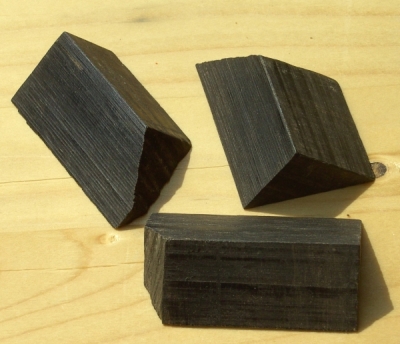Ebony is not native european wood.
I got some small pieces of ebony as a gift. That's why I decided to write about it here and I tried to find out some facts about this wood
It is one of the most expensive woods. If we hear of ebony we think that this wood should be consistently deep black, in fact there are different types and they may vary in color. There is for example ebony that has a dark green, dark brown to reddish color - it is even available in white
Becuase of its hardness it is really difficultto work with. It also tends to tear out and to splinter. The heartwood has no visible growth rings and it is very hard and heavy. The sap woodis kind of yellow-gray and is rather considered as worthless and therefore rarely traded.
When working with this wood one should should wear a respirator because the dust from sanding may cause irritation of skin, lungs and eyes.
Folgende Sorten gibt es (Quelle: Wikipedia):
- Ceylon-Ebenholz (Diospyros ebenum) ist die beste, heute kaum noch verfügbare Qualität: sehr hart, gut polierbar, praktisch ohne wahrnehmbare Poren, gut bearbeitbar, witterungs- und termitenfest. Das Ebenholz des Möbelbaus im 16.–19. Jahrhundert war von dieser Sorte.
- Madagaskar-Ebenholz (Diospyros perrieri) ist von eher dunkelbrauner Farbe, es ist sehr feinporig, witterungsfest, termitenfest und hat eine Dichte von ca. 1,0 kg/dm³.
- Makassar-Ebenholz (Diospyros celebica) (Indonesien) zählt zu den „farbigen“ Ebenhölzern und ist im Splint gelblichweiß, im Kernholz schwarz mit sehr charakteristischen hellgelb bis braungestreiften längsverlaufenden Maserungen; es ist sehr dicht und farbbeständig, sein Schleifstaub verursacht wie der aller Ebenhölzer Reizungen der Haut, Augen und Lunge. Seine Dichte beträgt 1,1 bis 1,3 kg/dm³. Im englischen Sprachraum wird es auch als Coromandelholz oder Marblewood bezeichnet.
- Mun-Ebenholz (Diospyros mun) kommt aus Laos und Vietnam und ist ähnlich wie Makassar-Ebenholz zweifarbig gestreift.



